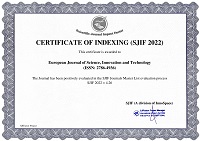Wood Energy as a Primary Livelihood Source and Its Impact on Forest Cover Management in the Hinterlands of Kindu and Kailo Territory, Maniema Province, DR Congo
Abstract
The present study assesses the production of wood energy as well as its socioeconomic and environmental impact in the hinterlands of the city of Kindu and the territory of Kailo, Maniema Province, DR Congo. The research employed a survey-based methodology, using Kobocollect to conduct a census of the study population. The findings identified 11 tree species exploited for wood energy, with five species—Cynometra alexandri, Gilbertiodendron dewevrei, Xylopia aethiopica, Uapaca sp. and Acacia sp.—being the most preferred by charcoal producers and firewood harvesters.
A total of 33920 trees are felled monthly across the two wood energy exploitation sites, averaging 18.8 stems per operator. The monthly quantities of charcoal (embers) and firewood are 2323,3 tonnes and 3369 m3 respectively, with an average of 2.1 tonnes and 4.8 m3.
Profit margins are proportional to the volume of production. For charcoal, profits range from 95000 FC to 1 064982,00 FC, with an average of 473915,17 FC. For firewood, profits range from 24900 FC to 99270 FC, with an average of 64476,25 FC. Financial profitability is positive for all charcoal operators and even exceeds 100% for firewood operators (700). These results indicate that wood energy production is economically viable and presents a profitable livelihood activity in the study area.
References
Aveling, C., Hall, J. & Wikie, D. (2004). Democratic Republic of Congo: Conservation, WWF (2001), WCS pp. 20-36.
Bangirimana, F., et al. (2015). Use of charcoal as the main source of energy for the urban population: A serious problem for the conservation of forest cover in Burundi, Article Bois et Forêts de Tropiques, 11 p.
Bikumu, R. (2005). The problem of energy deficit in the African Great Lakes sub-region. Pole Institute, 31 p.
Binzangi, K. (2004). Impact of wood fuel production in the DRC: Katanga, Kinshasa and Bas-Congo. Proceedings of the Training Seminar and High-Level Workshop on Environmental Assessment.2004. Kinshasa: pp105-122.
COMIFAC. (2010). The forests of the Congo Basin 20State of the Forests 2010. Douala, 274 p.
CTFT. (1989). Forester's Handbook. Rural Techniques in Africa, 3rd ed., Ministry of Development Cooperation, ISBN 2-11-0848874-X, Paris, 1213 p. in management decisions: contributions from the COFOr Change in the Congo Basin Forests project - State of the forests 2013. Belgium pp. 35 - 47.
Darpoux, R. & Rousel, M. (1982). Agricultural Market and Prices, Ed., JB., Ballière, Paris. 56p
Doumenge, C. (1990). The conservation of forest ecosystems in Zaire. Programfor tropical forests. IUCN, 242 p.
DPEDD / Maniema (2022). Annual Report of the Coordination’s activities, 32p.
Ebuy, A.J. (2009). Carbon estimation in INERA Yangambi plantations (DRC). Case of Autranella congolensis (De Wild), A. Chev, Gilbertiodendron dewevrei (De Wild), J. Léonard and “Drypetes likwa” (J. Léonard, Nomen). DES thesis, UNIKIS, 106p.
IIED. (1988). Report of the Seminar on Forest Policy in Zaire, Kinshasa, May 11-13, Washington DC, USA: 216 p
FAO. (2020). The State of the World's Forests: Forests, Biodiversity and Human Activities, Rome: https://doi.org/104060/co8624fr ISBN-92-5-132420-2, 223 p.
Gubry, P., Guérin, V., & Gubry, F. (1994). Six questions on the African population, Terres d'Afrique n°2, 32 p.
Mayaux, P., Achard, F., & Malingreau, J.P. (1998). Global tropical forest area measurements derived from coarse resolution satellite imagery: a comparison with other approaches. Environmental Conservation, 25, 37-52 p.
Mayaux, P., Bartholomé, E., Massart, M., Vancutsem, C., Cabral, A., Nonguierma, A., Diallo, O., Pretorius, C., Thompson, M., Cherlet, M., Pekel, J.F., Defourny, P., Vasconcelos, M., Di Gregorio, A., Fritz, S., De Grandi, G., Elvidge, C., Vogt, P., & Belward, A. (2003). A Land Cover Map of Africa, EUR 20665, EN (European Commission, Luxembourg), 20p.
Mbala, S.M. (2007). Democratic Republic of Congo. Mainstreaming gender issues in the forestry sector in Africa. Rome, FAO, 65p.
Mbayu, M.F. (2017). Marantaceae forest and its impact on woody regeneration in the Yoko Forest Reserve (Ubundu, Tshopo Province, DR Congo). Doctoral thesis, UNIKIS, 208 p.
Mbuangi, L.M. (2022). Socioeconomic and ecological issues of wood carbonization in the outskirts of the town of Boma (Kongo Central) in the Democratic Republic of Congo). Doctoral thesis, UNIKIS, 205p.
Mbengele, B., Mapoka, M., & Kapend, M. (2002). Energy needs of households in Kananga (DRC), Bulletin of the Geographical Society of Liège, 53-60.
Nazindigouba, E. (2008). Econometric analysis of household consumption of wood energy, Dissertation, Master 2, Faculty of Economics and Management, Nancy University. 53p
Nkamleu, B., Endamana, D., & Gockowski, J. (2002). Economic analysis of fuelwood consumption in forest regions: lessons from Cameroonian urban areas, Drought, Original note; 13 (2): 81p
N'sanda, B.L. (2010). Maniema Space and Lives, Royal Museum for Central Africa, p 301.
Nshimba, S.M.H. (2008). Floristic, ecological and phytosociological study of the forests of Mbiye Island in Kisangani, DR Congo. Brussels, ULB. Doctoral thesis, 271p.
Onadambo, T. (2014). Socio-economic impacts of the use of wild fauna and flora on the daily lives of populations living near the Kailo Forest Reserve in Maniema Province/DR Congo”. Doctoral thesis, UNIKIS, 140p.
Ouédraogo, B. (2007). Burkinabe wood energy sector: price structuring and analysis of profit distribution. Wood and tropical forests, 294(4): pp 75-88.
Schure, J. & Hunhyet, O. (2014). Development of a sustainable wood energy supply plan for the city of Kindu (Maniema) 58 p.
Tagirabo, B.J. (2023). Status of charcoal sales in the city of Bunia, Ituri Province in the Democratic Republic of Congo: issues and challenges. DES UNIKI dissertation 67p.
Tshimpanga, O.C. (2009). Study of the charcoal industry and its socioeconomic impact in Kisangani and its surrounding areas. DES thesis, UNIKIS, 89 p.
IUCN. (2022). Report on the Assessment of Opportunities for Landscape Restoration in Maniema, PIREDD Project. GIZ-IUCN-CAFI-FONAREDD, 177p.
USAID. (1981). Zaire. Country Ecological Profile. Harza Engineering Company. 53p.
Yakayengo, T.A. (2006). Contribution to the analysis of the trade in sawn timber (Avies) produced by hand in Kisangani and its surroundings. Dissertation, Faculty of Agricultural Sciences, UNIKIS, 37 p.
Copyright (c) 2025 Augustin Yakayengo Toko, Jean Pierre Ngongo Lushima, Sylvain Solia Edondoto, Faustin Mbayu Mpanya, Hippolyte Nshimba Seya wa Malale

This work is licensed under a Creative Commons Attribution 4.0 International License.


 ISSN
ISSN 











